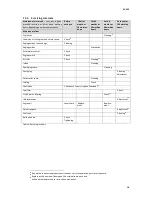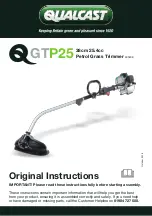
KC-435
7
−
when any persons or animals appear nearby
−
the engine can only be running when adjusting the carburettor or the engine revolutions
−
if a foreign object is hit. Check whether the brush cutter/trimmer is damaged; repair it when
necessary and continue the work only after it is put into normal condition.
−
if the brush cutter/trimmer shows unusual vibrations (find out and remove the cause of the
vibrations immediately).
!
Stop the engine in following cases:
−
always when you leave the brush cutter/trimmer unattended
−
before every refuelling
−
during every transportation or carrying.
!
All nuts, bolts and screws have to be properly tightened, so that the device is in safe and working order.
Regular maintenance is the basic condition for ensuring the safety of the operator and keeping the brush
cutter/trimmer in working order as well as preserving its perfect performance.
!
For safety reasons, don’t use the machine with worn out or damaged parts. The parts have to be replaced,
not repaired. Use original spare parts as a replacement (the blades should always be marked with the
proper symbols). Spare parts of insufficient quality can damage the device and can put your safety in
danger. The warranty claim will expire if non-original spare parts are used.
!
Use strong working gloves when dismounting or installing the cutting tool.
!
Never store the device with petrol in its tank inside a building where the fumes can get in touch with open
fire, spark or a source of high temperature.
!
Store the machine in a dry, clean place, out of reach of children.
!
Let the engine cool down before storing the machine in a closed space.
!
Make sure that remains of grass, leaves and excessive grease are removed from the brush cutter/trimmer
and especially from the engine, exhaust silencer and ventilation fins as well as from the place where
reserve petrol is stored. There is a risk of fire.
!
It is necessary to install the safety cover on the cutting blade for transport and before storing.
!
Drain the fuel in well-ventilated space only; the engine has to be cold. Don’t smoke and avoid access with
open fire.
!
To protect the environment, follow generally valid regulations when handling oil substances.
1.2.2
Noise and vibration values
With the 3-teeth blade / with the nylon head
Emission level of acoustic pressure A at operator’s place
4
Average emission level of acoustic pressure A for idle running (L
pAId
)
76 dB
76 dB
Average emission level of acoustic pressure A for running w/o load (L
pARa
)
98,2 dB
97,8 dB
Equivalent emission level of acoustic pressure A (L
pAeq
)
95,0 dB
95,0 dB
Declared equivalent emission level of acoustic pressure A (L
pAeq
)
99,0 dB
99,0 dB
Acoustic power
5
Guaranteed level of acoustic power (L
WA
)
111 dB
113 dB
Vibrations transmitted on the operator hands
6
Average overall vibration values for idle running (a
hv
)
1,75 ms
-2
1,4 ms
-2
Average overall vibration values for running without load (a
hv
)
6,3 ms
-2
4,35 ms
-2
Equivalent overall vibration values (a
hv.eq
)
4,6 ms
-2
3,2 ms
-2
Declared overall vibration value (a
hvd
)
6,9 ms
-2
4,8 ms
-2
Table 2: Noise and vibration values
!
Due to exceeded recommended values of noise and vibrations you should follow these instructions
when working with the machine:
4
Measured according to CSN EN ISO 11201 and CSN EN ISO 22868
5
According to the Directive 2000/14/EG
6
Measured according to CSN EN ISO 20643 and CSN EN ISO 22867








































